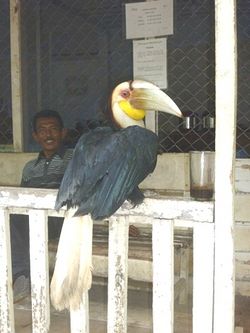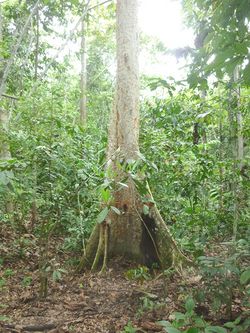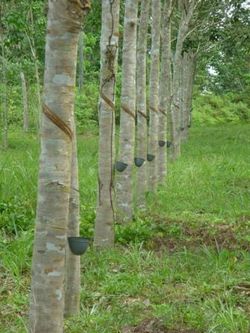CRC990 EFForTS
- Title: Sub-project B05 - Methodological approaches to the assessment of all tree resources in transition systems in forested tropical landscapes
- Funding: DFG Collaborative Research Center
- Duration: 2012-2015
- Link: CRC990 (EFForTS)
- Coordination: Prof. Dr. Christoph Kleinn
- Project researcher: Dian Melati (PhD)
- Study sites: Harapan landscape and Bukit Duabelas landscape, Jambi Province, Sumatra
Background
The decrease of natural forest area in the tropics is alarmingly high as a result of forest over-utilization and land use changes. The reasons are manifold, including increasing demand for forest products and transformation of natural forests into high yield tree or agricultural crops for food, fodder and biofuel. It is a challenge for research and development to develop approaches that contribute to conservation and enhancement of the forest resource and the functions and services that forests provide. Forest transition systems cover wide areas in many tropical regions, in particular where population pressure is high. An example is Jambi Province on Sumatra in Indonesia, where forest transition through deforestation and land conversion has proceeded at a rapid pace, resulting in a land cover dominated by rubber and oil palm plantations, with few remaining forest areas left.
This research is part of Scientific Project B05 (SP B05) of the Collaborative Research Centre 990. SP B05 is on methodological approaches to the assessment of all tree resources in the study areas, focusing on the estimation of above ground biomass and species richness (biodiversity) using an integrated approach of both field sampling and remote sensing. Numerous studies have been done on South East Asian vegetation types for the estimation of above ground biomass and various biomass models for tropical forest have been produced. However, application of these models to specific situations like the one in the CRC990 study area is frequently hampered by a number of uncertainties about the applicability, provenance and precision of these models and the lack of specific reference information. Regarding species richness estimation, there is the expectation that remote sensing may yield valuable information that allows improving the field sample based observations.
Project goals
This project establishes a sample-based system of long term observation plots (inventory) over a landscape that includes ecological core plots and villages where interviews take place. Planning of a suitable sampling design and plot design in regard to defined target variables will be done based on statistical considerations and is an integrated research question in this context. Field observations on measurable variables are taken in order to derive estimates on biomass (above ground biomass, dead wood, litter, and soil samples for C) and structure (biodiversity relevant attributes, including regeneration, species composition, crown cover). Together with findings from other sub-projects, regional estimates of biodiversity characteristics and carbon pools will be produced.
Specific research questions in this context are analysis and improvement of the error structure of biomass models and of approaches for the sample-based estimation of the total number of tree species in the area of interest. Remote sensing imagery (the German vegetation-optimized satellite RapidEye system and the new Indonesian satellite system from 2013 onwards) serve as carrier data to regionalize carbon and habitat characteristics. These maps allow a second (not independent, however) estimation of carbon pools and biodiversity characteristics and serve as input for spatial analyses for other scientific projects, including those which research into use and perception of natural resources within villages. The project will provide spatially predicted information about the resource around those villages up to a distance to be defined. In addition, it allows extrapolating process-oriented findings from the core plots to the landscape and allows comparisons of the approach of ecological plots (small sample size & larger plots) to that of observational studies (larger sample size & smaller inventory plots). The permanent installation of the sample plots allows for repeated measurements at later project phases and offers an excellent option for the assessment of vegetation structure and estimation on changes over time. Depending on the imagery available, this project will yield input information to other scientific projects. Furthermore, depending on input from other projects, regionalization may also be done for other carbon pools than above ground biomass only (i.e. for soil carbon and below ground biomass).
Work plan
- Evaluate the application of biomass models on landscape level in transformation systems, including error analysis.
- Estimating biomass and species richness for study sites in lowland rainforest, jungle rubber, intensive rubber and oil palm plantations within the study region and optimize the integration of field sampling and remote sensing analysis.
- Analyze and evaluate the applicability of remote sensing in Jambi Province, in particular with respect to cloud cover, topography and the particular spatial pattern of a transformation landscape.
- Optimizing field sampling for integration with remote sensing for biomass estimation and estimation of biodiversity components.
Partners
German project partners:
- Different sub-projects in context of the CRC990
Indonesian project partners:


